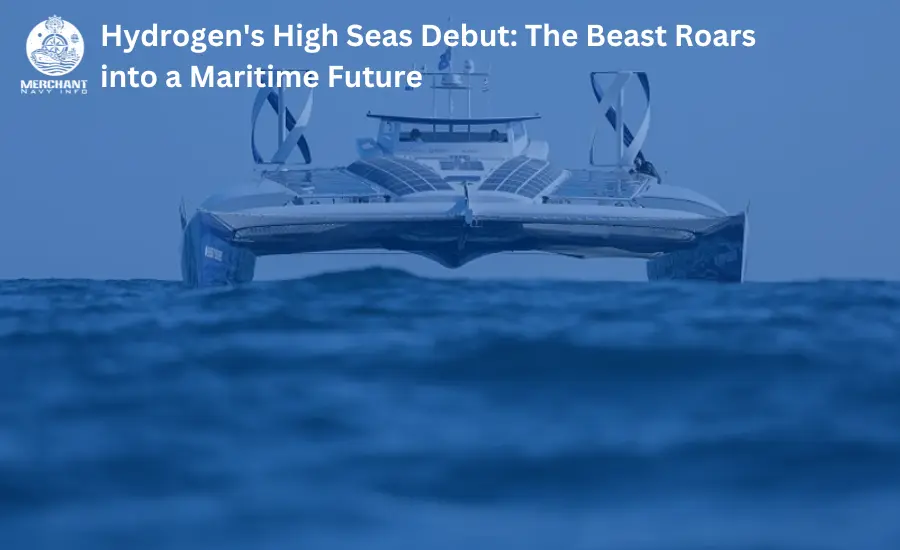
The maritime industry, long reliant on fossil fuels, faces a turning tide. As environmental concerns mount and regulations tighten, the search for clean and sustainable alternatives intensifies. Enter the “Beast,” a powerful hydrogen-powered racing boat, as reported by LaGrada Online, that serves as a roaring testament to the potential of hydrogen in propelling maritime transportation into a cleaner future. This blog post delves deeper into the “Beast” project, explores the broader context of hydrogen in maritime applications, and examines the opportunities and challenges that lie ahead in this transformative journey.
Breaking the Mold: Uncaging the Power of the “Beast”:
The “Beast,” envisioned by Victory Team racing and Green Propulsion, showcases a revolutionary hydrogen-powered engine capable of generating 2,000 horsepower [1]. This impressive feat marks a significant step forward in several ways:
- Zero-Emission Performance: Unlike its gas-guzzling counterparts, the “Beast” emits only water vapor as a byproduct, significantly reducing its environmental impact.
- Powerful Performance: The impressive horsepower output demonstrates the potential of hydrogen to deliver the thrust and speed required for high-performance vessels.
- Tech Showcase: The project serves as a valuable testbed for hydrogen technology, paving the way for wider adoption in the commercial marine sector.
Navigating the Horizon: Hydrogen’s Maritime Promise:
The “Beast” isn’t a lone wolf. Hydrogen holds immense potential for decarbonizing the maritime industry:
- Clean Energy Source: Its abundance and renewability offer a sustainable alternative to fossil fuels, aligning with global emission reduction goals.
- High Energy Density: Compared to batteries, hydrogen offers higher energy density, enabling longer vessel range and potentially reducing refueling frequency.
- Technological Advancements: Ongoing research and development are improving the efficiency and affordability of hydrogen production, storage, and fuel cell technology.
Charting the Course: Challenges and Opportunities:
Despite its promise, several hurdles need to be overcome before hydrogen gains widespread adoption:
- Infrastructure Limitations: The current limited network of hydrogen bunkering stations creates a major barrier for wider use, particularly outside major ports.
- High Costs: Hydrogen production, storage, and fuel cell technology remain relatively expensive compared to traditional alternatives.
- Regulatory Frameworks: Clear and harmonized regulations are needed to promote investment and ensure the safety and sustainability of hydrogen operations.
Collaboration for Collective Change:
Fortunately, collaboration is driving progress:
- Industry Partnerships: Leading companies are joining forces to develop hydrogen-powered vessels, share best practices, and advocate for infrastructure development.
- Government Initiatives: Several governments are implementing incentives and support programs to accelerate the transition to clean maritime fuels.
- Technological Innovation: Ongoing research and development are focused on lowering costs, enhancing efficiency, and optimizing hydrogen technology for maritime applications.
Merchant Navy in the Hydrogen Era:
The “Beast” and the broader push for hydrogen have implications for the Merchant Navy:
- New Skillsets: Operating and maintaining hydrogen-powered vessels requires specialized knowledge and training, creating new career opportunities for seafarers.
- Technological Advancements: Adapting to new technologies will be crucial, necessitating continuous learning and skill development within the workforce.
- Environmental Responsibility: Embracing clean fuels like hydrogen aligns with the Merchant Navy’s growing commitment to sustainable practices and environmental protection.
Beyond the Finish Line: A Sustainable Voyage Awaits:
The “Beast” has taken the first strides, demonstrating the viability of hydrogen in high-performance maritime applications. While challenges remain, collaborative efforts and ongoing innovation pave the way for a cleaner and more sustainable future for the maritime industry. By embracing this clean-burning fuel, the Merchant Navy can write a new chapter in its storied history, navigating towards a future where the oceans remain vibrant and healthy, and maritime trade thrives in harmony with our planet.










